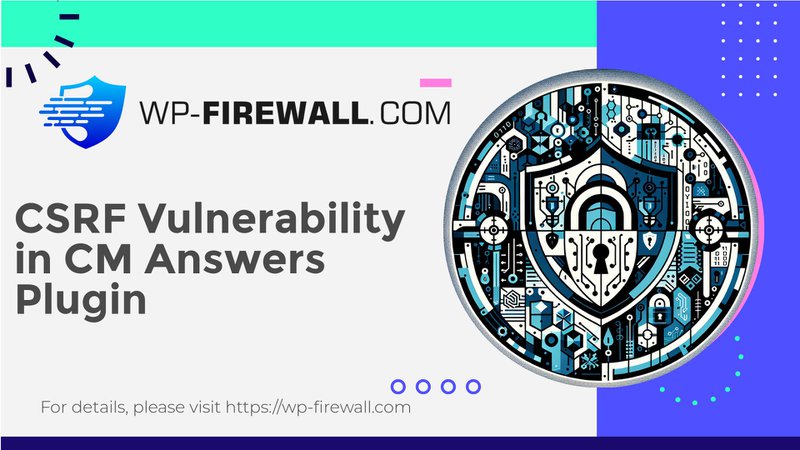
Understanding and Mitigating Cross-Site Request Forgery (CSRF) Vulnerabilities in WordPress Plugins
As a WordPress security expert, it's crucial to address the growing concern of Cross-Site Request Forgery (CSRF) vulnerabilities in WordPress plugins. Recently, a CSRF vulnerability was identified in the CM Answers plugin, version 3.3.3, which highlights the need for robust security measures to protect WordPress sites from such threats. In this article, we will delve into the nature of CSRF attacks, their impact on WordPress sites, and strategies for mitigation.
What is Cross-Site Request Forgery (CSRF)?
Cross-Site Request Forgery (CSRF) is a type of web application vulnerability that allows an attacker to trick a user into performing unintended actions on a web application that the user is authenticated to. This is achieved by exploiting the trust that a web application has in a user's browser. When a user is logged into a web application, their browser stores session cookies that identify them as an authenticated user. An attacker can create a malicious website that makes requests to the vulnerable web application, using the user's session cookies to authenticate the request.
How Does a CSRF Attack Work?
For a CSRF attack to be successful, three conditions must be met:
- Cookie-Based Session Handling: The web application must use session cookies to identify users. WordPress, like many other web applications, relies on session cookies to manage user sessions.
- User Authentication: The user must be authenticated to the web application. This means the user has logged in and has a valid session cookie stored in their browser.
- Malicious Request: The attacker must trick the user into making a request to the web application. This can be done through various means, such as embedding malicious code in an email or on a website that the user visits.
Impact of CSRF on WordPress Sites
CSRF vulnerabilities in WordPress plugins can have severe consequences:
- Unauthorized Actions: An attacker can use a CSRF vulnerability to perform actions on behalf of an authenticated user, such as changing passwords, deleting content, or even taking control of the user's account.
- Data Compromise: If an attacker gains access to an administrative account, they can compromise sensitive data stored on the site or even install malware.
- Financial Risks: In cases where a WordPress site is used for financial transactions, a successful CSRF attack could lead to unauthorized financial transfers.
Case Study: CM Answers Plugin
The CM Answers plugin, version 3.3.3, has been identified with a CSRF vulnerability. This vulnerability allows an attacker to perform actions on behalf of an authenticated user, potentially leading to unauthorized changes or data breaches. It is essential for users of this plugin to update to a patched version as soon as possible to mitigate this risk.
Mitigating CSRF Vulnerabilities
Mitigating CSRF vulnerabilities involves both preventive measures and reactive strategies:
Preventive Measures
- Plugin Updates: Regularly update WordPress plugins to ensure you have the latest security patches. Many CSRF vulnerabilities are fixed in newer versions of plugins.
- Token-Based Validation: Implement token-based validation for forms. This involves generating a unique token for each form submission and verifying it on the server side to ensure the request is legitimate.
- Same-Origin Policy Enforcement: Ensure that your web application enforces the same-origin policy, which restricts web pages from making requests to a different origin (domain, protocol, or port) than the one the web page was loaded from.
- User Education: Educate users about the risks of clicking on suspicious links or submitting forms from untrusted sources.
Reactive Strategies
- Monitoring and Detection: Use security tools to monitor your site for suspicious activity. Early detection can help mitigate the impact of a CSRF attack.
- Incident Response Plan: Have an incident response plan in place to quickly respond to security breaches. This includes procedures for notifying affected users and restoring site integrity.
- Security Audits: Regularly conduct security audits to identify vulnerabilities before they can be exploited.
Conclusion
Cross-Site Request Forgery (CSRF) vulnerabilities pose a significant threat to WordPress sites, especially those using plugins with known vulnerabilities. By understanding how CSRF attacks work and implementing robust security measures, site owners can protect their users and data from these threats. Regular updates, token-based validation, and user education are key strategies in preventing CSRF attacks. In the event of an attack, having a solid incident response plan and conducting regular security audits can help mitigate the damage.
As WordPress security experts, it is our responsibility to stay vigilant and ensure that our sites are protected against evolving threats like CSRF vulnerabilities. By prioritizing security and staying informed about the latest vulnerabilities, we can safeguard the integrity of our WordPress sites and protect our users from potential harm.
Essential Security Tips for WordPress Site Owners
- Regularly Review Plugin Lists: Ensure that all installed plugins are necessary and up-to-date. Remove any unused plugins to reduce the attack surface.
- Use a Web Application Firewall (WAF): A WAF can help filter out malicious traffic and prevent attacks before they reach your site.
- Implement Two-Factor Authentication (2FA): Adding an extra layer of authentication can make it more difficult for attackers to gain unauthorized access, even if they exploit a CSRF vulnerability.
By combining these strategies, WordPress site owners can significantly enhance their site's security posture and protect against CSRF vulnerabilities.

